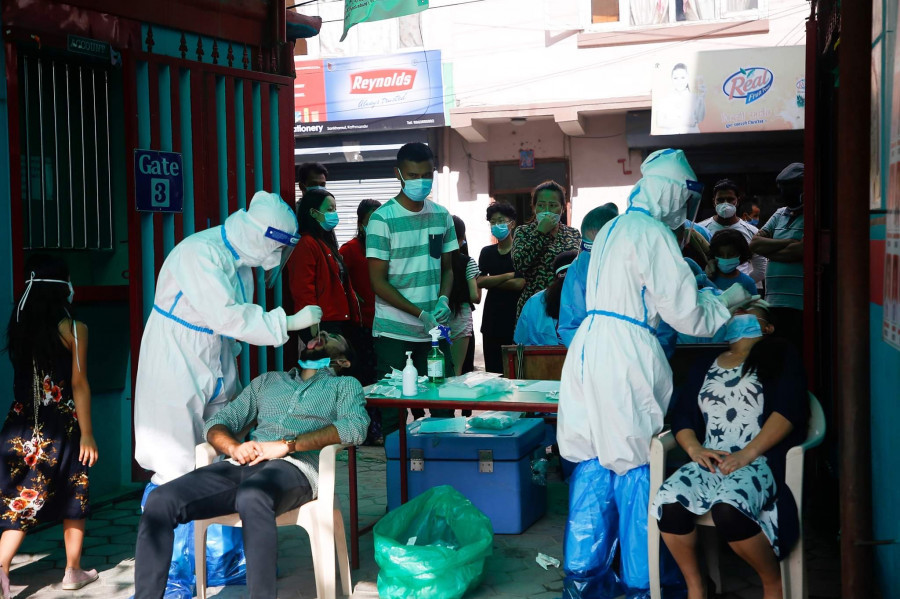Health
Covid-19 is sickening and killing people of all age groups in Nepal
Doctors say attributing coronavirus-related deaths simply to pre-existing and underlying conditions is akin to refusing to accept the threat of the virus which has penetrated society.
Arjun Poudel
On Thursday, Nepal reported eight more coronavirus deaths, taking the tally to 183.
According to the Ministry of Health data, 88 of the victims are aged between 31 and 60 years. Of the 183 people who have lost their lives to the virus so far, 17 were aged 31-40; 42 were aged 41-50, and 29 were between 51 and 60 years of age. The rest were either above 60 or below 30 years of age.
Though officials say 90 percent of those who died had pre-existing medical conditions, doctors say such a sweeping statement by those in authority could be costly for the country, as there is a need also to dig deeper into demography.
According to public health experts, attributing Covid-19 deaths to pre-existing and underlying medical conditions is tantamount to refusing to recognise the real threat of the virus.
“Youths and working class people have been infected and have died throughout the globe,” Dr Anup Bastola, spokesperson for the Sukraraj Tropical and Infectious Disease Hospital, told the Post.
“In our country also, the young population is getting infected and dying. Data shows that people who are in their highly productive age are dying. This can have long-term consequences.”
Doctors agree that people with underlying and pre-existing conditions are at bigger risk of dying from Covid-19, but the authorities should step up measures to ensure swift treatment for patients rather than just counting the numbers.
Chronic ailments like hypertension, diabetes, cholesterol and thyroid have been reported in Nepalis from their early 30s.
Several studies, including the result of the STEPS survey on non-communicable disease risk factors, which is the population-based household survey of adults between 15 and 69 years carried out on 6,450 individuals, showed that 24.5 percent of the respondents (almost one in four) have high blood pressure.
About nine percent of the respondents had high blood sugar levels. Eleven percent of the respondents said they have high cholesterol.
Results of another study—Burden of non-communicable disease in Nepal—published last year show that of the total national deaths, 12 percent were caused by chronic obstructive pulmonary disease.
“Death is not just about numbers,” said Dr Baburam Marasini, former director at the Epidemiology and Disease control Division. “The authorities need to try to save people from dying, rather than simply saying every other death was due to some pre-existing medical condition.”
Ever since the first Covid-19 case was reported back in January, Nepali authorities have shown reluctance to recognise the threat.
In the initial days, people in power, including the prime minister and ministers, peddled misinformation and made futile efforts to declare Nepal a coronavirus-free country. The first death was reported on May 14, a day after President Bidya Devi Bhandari addressed the nation defending the KP Oli administration’s “efforts” in the fight against the pandemic.
When two deaths were confirmed, Prime Minister Oli was still reluctant to attribute them to Covid-19. While addressing Parliament, Oli said they had died of “some other reasons”.
Public health experts and doctors have for long alleged that the government has defied science and ignored their suggestions as Covid-19 spread in the country.
As of Thursday, according to the Ministry of Health, the country has reported 35, 529 Covid-19 cases across the country, with 1,111 new infections reported in the last 24 hours. As many as 377 new cases were reported in Kathmandu Valley, where the total number of coronavirus cases has reached 4,396.
Dr Madhu Devkota, a professor at the Tribhuvan University Institute of Medicine, said that people of all age groups are highly vulnerable to Covid-19.
“What is worrying is while the infection and death rate among the elderly is rising, working class people are too highly exposed to the virus,” Devkota told the Post. “Working class people are more mobile than the elderly people.”
In a bid to break the virus transmission chain, the Oli government has asked chief district officers to take measures, including prohibitory orders.
Chief district officers of the Kathmandu Valley, who issued prohibitory orders effective August 19 midnight for a week, on Wednesday decided to extend the restrictions until September 2 midnight. Public health experts and doctors, however, have been saying that just extendinng curbs won’t help fight the virus, as it has taken hold in society.
Devkota said that along with such measures, the authorities must focus on curative measures as well–isolation and treatment of the infected–to save lives.
“The authorities should arrange for more intensive care unit beds and more ventilators,” said Devkota. “The way the cases are rising and more deaths are being reported shows the virus has penetrated the community. The death rate could go up. The government must step up measures to save lives.”




 15.12°C Kathmandu
15.12°C Kathmandu














